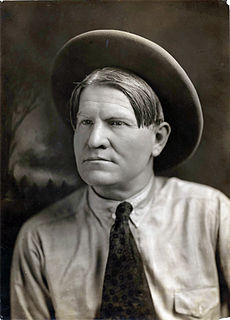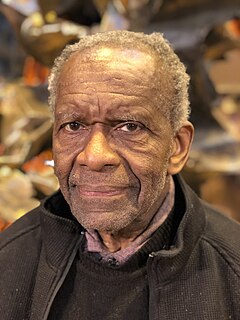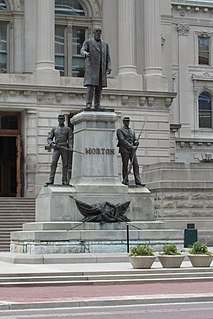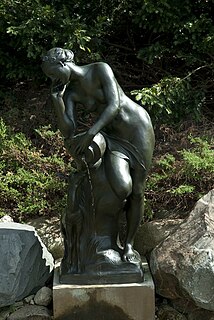Related Research Articles

Lee Oscar Lawrie was one of the United States' foremost architectural sculptors and a key figure in the American art scene preceding World War II. Over his long career of more than 300 commissions Lawrie's style evolved through Modern Gothic, to Beaux-Arts, Classicism, and, finally, into Moderne or Art Deco.

Charles Marion Russell, also known as C. M. Russell, Charlie Russell, and "Kid" Russell, was an American artist of the American Old West. He created more than 2,000 paintings of cowboys, Native Americans, and landscapes set in the western United States and in Alberta, Canada, in addition to bronze sculptures. He is known as "the cowboy artist" and was also a storyteller and author. He became an advocate for Native Americans in the west, supporting the bid by landless Chippewa to have a reservation established for them in Montana. In 1916, Congress passed legislation to create the Rocky Boy Reservation.

The Oklahoma State Capitol is the house of government of the U.S. state of Oklahoma. It is the building that houses the Oklahoma Legislature and executive branch offices. It is located along Lincoln Boulevard in Oklahoma City and contains 452,508 square feet of floor area. The present structure includes a dome completed in 2002.

Richard Howard Hunt is one of the most important African American sculptors of the 20th-century. Hunt holds status as one of the foremost African-American abstract sculptors and artists of public sculpture. Hunt, the descendant of slaves, was the first African American sculptor to have a major retrospective at Museum of Modern Art in 1971. Hunt has created over 150 public sculpture commissions in prominent locations in 22 states across the United States, more than any other sculptor. With a career that spans seven decades, Hunt has held over 100 solo exhibitions and is represented in more than 100 public museums. Hunt has served on the Smithsonian Institution's National Board of Directors. Hunt's abstract, modern and contemporary sculpture work is notable for its presence in exhibitions and public displays as early as the 1950s, despite social pressures for the obstruction of African-American art at the time.
Allan Capron Houser or Haozous was a Chiricahua Apache sculptor, painter and book illustrator born in Oklahoma. He was one of the most renowned Native American painters and Modernist sculptors of the 20th century.

Appeal to the Great Spirit is a 1908 equestrian statue by Cyrus Dallin, located in front of the Museum of Fine Arts, Boston. It portrays a Native American on horseback facing skyward, his arms spread wide in a spiritual request to the Great Spirit. It was the last of four prominent sculptures of Indigenous people, which also includes A Signal of Peace (1890), The Medicine Man (1899), and Protest of the Sioux (1904).

Enoch Kelly Haney is an American politician and internationally recognized Seminole/Muscogee artist from Oklahoma, He served as principal chief of the Seminole Nation of Oklahoma from 2005 until 2009 and previously served as a member of both houses of the Oklahoma Legislature. He was also a candidate for the office of Governor of Oklahoma in the 2002 election.
The Herron Arch 1, a public sculpture by American artist James Wille Faust, is located on the Indiana University-Purdue University Indianapolis campus, which is near downtown Indianapolis, Indiana. The sculpture is located at the corner of New York and Blackford Streets, the north-east corner of the Herron School of Art and Design. Faust, an alumnus of Herron, created the 20-foot-tall (6.1 m), vividly colored aluminum sculpture for Herron's eighteen-month-long Public Sculpture Invitational.
Robert Dale Owen Memorial is a public artwork located at the south entrance of the Indiana Statehouse along Washington Street in Indianapolis, Indiana. The memorial was donated to the state of Indiana and dedicated in 1911 in honor of the Indiana politician, Robert Dale Owen (1807–1877). The bronze portrait bust by Indiana sculptor, Frances M. Goodwin, has been missing from this memorial since 1970. The memorial's remaining pedestal is made from three stone blocks and includes a commemorative plaque.

Young Abe Lincoln, is a 1962 public artwork by American artist David K. Rubins, located outside of the government center near the Indiana State House, in Indianapolis, Indiana, US. This bronze sculpture is a depiction of a young Abraham Lincoln, an Abraham Lincoln that spent the majority of his formative years in Indiana.

Benjamin Harrison is a bust by American artist Richard Peglow, located in the north atrium on the second floor of the Indiana Statehouse in Indianapolis, Indiana, United States. The bust is cast in bronze and depicts President Benjamin Harrison. The bust is placed in front of a grey and black marble shield with six stars tracing around the edge of the shape. The bust and shield are approximately 28 inches (710 mm) wide by 25 inches (640 mm) high and has a depth of 14.5 inches (370 mm). The artwork was cast and placed in the statehouse in 2008 in accordance with Indiana code Section 2. IC 4-20.5-6-12.

The Abraham Lincoln commemorative plaque is a work of public art designed by Marie Stewart in 1906, created by Rudolph Schwarz, and dedicated on 12 February 1907.

Oliver P. Morton and Reliefs is a public artwork by Austrian artist Rudolph Schwarz, located on the east side of the Indiana Statehouse in Indianapolis, Indiana, at the intersection of North Capitol Avenue and West Market Street.

Coal Miner is a public artwork by Polish American artist John J. Szaton (1907–1966) which is located in two US State capitals; the original, commissioned in 1963 in Springfield, Illinois, as well as a copy on the west lawn of the Indiana State House in Indianapolis The statues commemorate coal miners who had lost their lives in those states' mining industry. The 7-foot (2.1 m) tall statue rests on a 3-foot (0.91 m) square, granite base supported by a cement foundation that is 4–6 inches (100–150 mm) thick.

Nymph and Fawn is a public artwork by American artist Isidore Konti and located within the Oldfields–Lilly House & Gardens estate on the grounds of the Indianapolis Museum of Art (IMA), near Indianapolis, Indiana. Created in 1917, the bronze sculpture is also a working fountain. It portrays a female nude pouring water from an urn while standing beside a small fawn.
Omri Amrany is an Israeli-American best known as a sculptor and painter, though he also works in architecture and wall tapestry art. Philosophically a humanist, the human figure is his main subject matter. He is co-founder of the Fine Art Studio of Rotblatt-Amrany in Fort Sheridan, Illinois, a studio that brings to the United States the aims and traditions of the Ateliers of Europe, as well as The Julia Foundation, a not-for-profit arts organization.

Gary Tillery is an American writer and artist known for his biographies focusing on the spiritual lives of famous figures, and for his public sculptures. His 2009 book, The Cynical Idealist, was named the official book of the 2010 John Lennon Tribute in New York City,

Steven Weitzman is an American public artist and designer known for his figurative sculptures, murals, and aesthetic designs for highway and bridge infrastructure projects.

Robert Henry Hess was an American sculptor and art educator. He was best known for his abstract metal sculptures and wood carvings. Hess served on the faculty of Willamette University in Salem, Oregon for 34 years. Today, his works are found in prominent public spaces and private collections throughout the Pacific Northwest.
Harry Andrew Jackson, born Harry Aaron Shapiro Jr., was an American artist. He began his career as a Marine combat artist, then later worked in the abstract expressionist, realist, and American western styles.
References
- 1 2 "Wayne Cooper (1942— )." AskArt. (retrieved 1 Feb 2011)
- 1 2 "Native American art calendar, book signing scheduled." Cheyenne-Arapaho Tribal Tribune. 1 Dec 2009 (retrieved 1 Feb 2011)